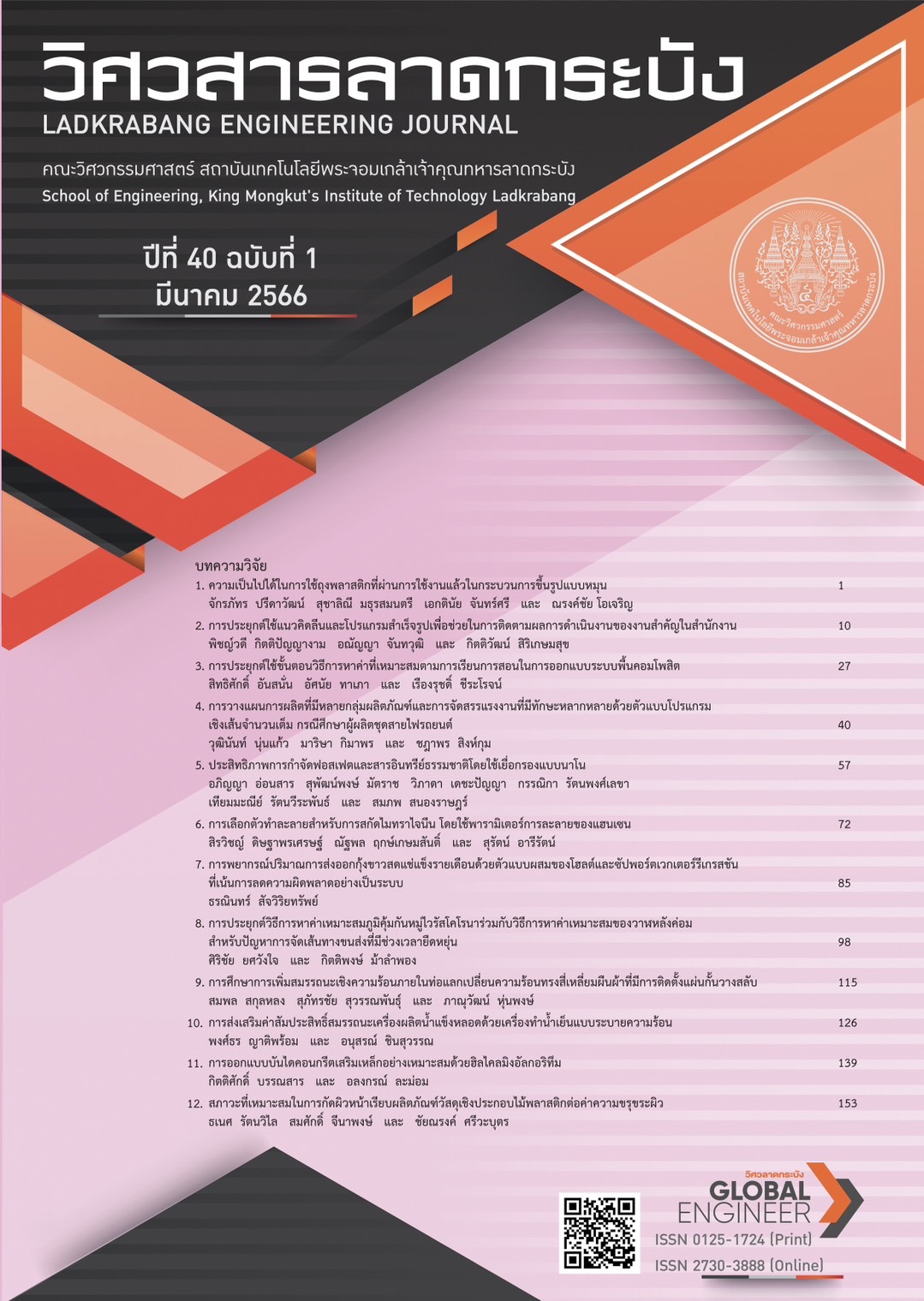Suitable Condition for Face Milling of Wood-Plastic Composite Products on Surface Roughness
Keywords:
Wood-plastic composites, Surface roughness, Vertical milling machineAbstract
This research aimed to study the suitable condition of a face milling and plastic types on surface roughness of commercial wood-plastic composites (WPCs). The experiment consisted of 4 factors; spindle speed, feeding rate, depth of cut and types of WPCs. Three levels of cutting condition were the spindle speeds at 250, 500, and 710 rpm, feeding rates at 125, 315, and 630 mm/min, and depths of cut at 0.50, 0.75, and 1.00 mm whereas 3 types of WPCs were combination of PE, PP or PVC with wood-flour. The results show that the lowest surface roughness of WPCs was 1.70, 2.64, and 1.78 µm., obtained from the composites PP, PVC, and PE at the cutting conditions of spindle speed 500, 710, and 500 rpm, the feeding rates 315, 125, and 125 mm per minute, and the depths of cut 0.75, 1.00, and 0.50 mm, respectively. Furthermore, the surface roughness value of the composites was affected by the different type of WPCs whereas the lowest to the highest surface roughness values were given by the PP, PVC, and PE composites, respectively.
References
M. Chaharmahali, M. Tajvidi and S. K. Najafi, “Mechanical properties of wood plastic composite panels made from waste fiberboard and particleboard,” Polymer Composites, vol. 10, no 3, pp. 606-610, 2008. doi: 10.1002/pc.20434.
S. Tamrakar and R. A. Lopez-Anido, “Water absorption of wood polypropylene composite sheet piles and its influence on mechanical properties,” Construction and Building Materials, vol. 25, no. 10, pp. 3977–3988, 2011. doi: 10.1016/j.conbuildmat. 2011.04.031.
S. Sriarkarin, S. Suksard, W. Hoamuangkaew, and S. Jarusombuti, “Marketing of wood plastic composite products in Thailand,” Thai Journal of Forestry, vol 31, no 1, pp. 46–54, 2022.
C. Srivabut, T. Ratanawilai and S. Hiziroglu, “Response surface optimization and statistical analysis of composites made from calcium carbonate filler-added recycled polypropylene and rubberwood fiber,” Journal of Thermoplastic Composites Material, vol 35, no 3, pp. 391–415, 2022, doi: 10.1177/0892705719889988.
N. Ayrilmis, U. Buyuksari and T. Dundar, “Waste pine cones as a source of reinforcing fillers for thermoplastic composites,” Journal of Applied Polymer Science, vol. 117, no. 4, pp. 2324–2330, 2010, doi: 10.1002/app.32076.
R. Z. Huang, B. J. Kim, S. Lee, Z. Yang and Q. L. Wu, “Co-extruded wood-plastic composites with talc-filled shells: morphology, mechanical, and thermal expansion performance,” BioResources, vol. 8, no. 2, pp. 2283–2299, 2013, doi: 10.15376/biores. 8.2.2283-2299.
S. Rimdusit, W. Smittakorn, S. Jittarom and S. Tiptipakorn, “Highly filled polypropylene rubber wood flour composites,” Engineering Journal, vol 15, no. 2, pp. 17–30, 2011, doi: 10.4186/ej.2011.15.2.17.
C. Homkhiew and T. Ratanawilai, “Optimal proportions of composites from polypropylene and rubberwood flour after water immersion using experimental design,” KKU Research Journal, vol. 19, no. 6, pp. 780–793, 2014.
T. Ratanawilaia, P. Pitsuwan, S. Jirasampata and C. Homkhiew, “Influence of Milling Factors on Surface Finish of Wood-Plastic Composites,” Ladkrabang Engineering Journal, vol. 32, pp. 43–48, 2015.
C. Srivabut, S. Rawangwong, C. Homkhiew and J. Rodjananugoon, “Optimal condition on surface roughness in side milling of high-density polyethylene and rubberwood flour composites using response surface methodology,” Ladkrabang Engineering Journal, vol 39, no 1, pp. 23–34, 2022.
E. O. Olakanmi, E. A. Ogunesan, E. Vunain, R. A. Lafia-Araga, M. Doyoyo and R. Meijboom, “Mechanism of fiber/matrix bond and properties of wood polymer composites produced from alkaline-treated daniella oliveri wood flour,” Journal of Polymer Composites, vol. 37, no.9, pp. 2657–2672, 2016, doi: 10.1002/pc.23460
C. Srivabut, C. Homkhiew and S. Rawangwong, “Optimal composition on surface roughness of wood-plastic composites using mixture design and response surface methodology,” Ladkrabang Engineering Journal, vol 38, no 4, pp. 151–165, 2021.
J. Lamaming, R. Hashim, O. Sulaiman, T. Sugimoto, M. Sato and S. Hiziroglu, “Measurement of some properties of binderless particleboards made from young and old oil palm trunks,” Measurement, vol 47, pp. 813–819, 2014. doi: 10.1016/j.measurement.2013.10.007
C. Srivabut, A. T. Kamnerdwam, C. Homkhiew, S. Rawangwong and T. Ratanawilai, “Response Surface Optimization on Flexural Properties of Wood-Plastic Composites for Structure Materials Exposed to High Moisture Content,” The Journal of Industrial Technology, vol 18, no 1, pp. 1–20, 2022, doi: 10.14416/j.ind.tech.2022.02.001
S. Rawangwong and J. Chatthong, “The study favorable conditions for the cutting text on Para wood by computer numerical controlled milling”, in 16th IE Network Conference, Phuket, Thailand, Oct. 24–26, 2007, pp. 121–129.
Z. Hutyrova, J. Zajac, P. Michalik, D. Mital, J. Duplak and S. Gajdos, “Study of surface roughness of machined polymer composite material,” International Journal of Polymer Science, vol. 1, pp. 1–6, 2015, doi: 10.1155/2015/303517
C. Tasdemir, I. H. Basboga and S. Hizirogiu, “Surface Quality of wood plastic composites as function of water exposure,” Applied Sciences, vol. 10, pp.156–167, 2020. doi: 10.3390/app10155122
Wechsler and S. Hiziroglu, “Some of the properties of wood–plastic composites,” Building and Environment, vol. 42, pp.2637–2644, 2007, doi: 10.1016/j.buildenv.2006.06.018
Downloads
Published
How to Cite
Issue
Section
License
Copyright (c) 2023 Faculty of Engineering, King Mongkut’s Institute of Technology Ladkrabang

This work is licensed under a Creative Commons Attribution-NonCommercial-NoDerivatives 4.0 International License.
The published articles are copyrighted by the School of Engineering, King Mongkut's Institute of Technology Ladkrabang.
The statements contained in each article in this academic journal are the personal opinions of each author and are not related to King Mongkut's Institute of Technology Ladkrabang and other faculty members in the institute.
Responsibility for all elements of each article belongs to each author; If there are any mistakes, each author is solely responsible for his own articles.






